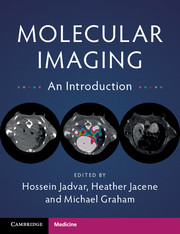Book contents
- Frontmatter
- Contents
- List of Contributors
- Preface
- 1 Instrumentation – CT
- 2 MRI/ MRS Instrumentation and Physics
- 3 Optical and Ultrasound Imaging
- 4 Instrumentation-Nuclear Medicine and PET
- 5 Quantitation-Nuclear Medicine
- 6 Perfusion
- 7 Metabolism
- 8 Cellular Proliferation
- 9 Hypoxia
- 10 Receptor Imaging
- 11 Apoptosis
- 12 Angiogenesis
- 13 Reporter Genes
- 14 Stem Cell Tracking
- 15 Amyloid Imaging
- Index
- References
5 - Quantitation-Nuclear Medicine
Published online by Cambridge University Press: 22 November 2017
- Frontmatter
- Contents
- List of Contributors
- Preface
- 1 Instrumentation – CT
- 2 MRI/ MRS Instrumentation and Physics
- 3 Optical and Ultrasound Imaging
- 4 Instrumentation-Nuclear Medicine and PET
- 5 Quantitation-Nuclear Medicine
- 6 Perfusion
- 7 Metabolism
- 8 Cellular Proliferation
- 9 Hypoxia
- 10 Receptor Imaging
- 11 Apoptosis
- 12 Angiogenesis
- 13 Reporter Genes
- 14 Stem Cell Tracking
- 15 Amyloid Imaging
- Index
- References
Summary
Biodistribution
Perhaps the simplest example of radiotracer quantification is the biodistribution study done in small animals, such as mice or rats. The animal is sacrificed at some well-defined time after administration of radiotracer, various organs are removed, weighed, and then counted in a scintillation well counter. The resultant counts are usually determined in units of counts per minute (cpm) per gram. These counts are meaningful only in comparison to some other count such as the administered dose or in comparison to other tissues, that is ratios. Such ratios are often useful measures of uptake, that is heart:blood, brain:muscle, tumor:muscle, and so on, but are not an adequate description of tracer behavior by themselves. A high tumor:muscle ratio can be due to high tumor uptake or low muscle uptake. Without a measure of absolute uptake, it is not possible to judge if the uptake is high enough to be experimentally or clinically useful. The other problem that is inherent in simple biodistribution studies is that the activity in tissue is dynamic and thus is dependent on the timing of the sacrifice of the animal. The selection of the appropriate time is not trivial and needs to incorporate an understanding of the physiologic behavior of the tracer. Some tracers, such as highly diffusible blood flow tracers (water, butanol, iodoantipyrine), have very rapid kinetics and sacrifice is often within seconds after intravenous administration. Others are taken up more slowly and reach steady state only after hours.
Indicator Dilution
Plasma and red blood cell volumes are commonly determined using the method of indicator dilution. The underlying concept is that the concentration of an inert tracer in a volume is the amount administered divided by the volume, that is C = X/V, where C is the concentration (µCi/ml), X is the amount administered (µCi), and V is volume (ml). Volume can be measured in another version of the formula: V = X/C. For plasma volume determination, plasma concentration is usually measured in a well counter in units of cpm/ml. It is somewhat more complex to determine the amount administered in the appropriate units, that is cpm. The simple approach is to put the injected dose into a well counter just before injection and determine the cpm.
- Type
- Chapter
- Information
- Molecular ImagingAn Introduction, pp. 23 - 27Publisher: Cambridge University PressPrint publication year: 2017



